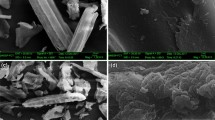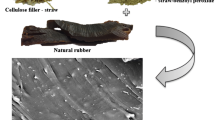Abstract
Clusia multiflora sawdust (CMS) was evaluated as filler in rubber composites. CMS at 40 phr was mixed with synthetic styrene butadiene rubber (SBR 1502), the blend was compatibilized with 8 phr of maleated polyethylene (MAPE). To evaluate the curing and mechanical behavior of CMS, it was compared with precipitated silica (reinforcing filler); calcium carbonate and kaolin (non-reinforcing minerals). The addition of CMS reduced the mechanical properties of rubber compound compared to silica rubber/silica composite. The tensile and tear strength values for SBR/CMS were similar to SBR/CaCO3 and SBR/kaolin. The addition of MAPE to SBR/CMS composite slightly improved the tensile strength, tear strength, abrasion resistance and hardness. In general, CMS performed as diluent filler which reduced the weight of the composite. CMS slightly affected curing speed of SBR/CMS blends. CMS is a waste generated by the use of Clusia multiflora (a timber species endemic of mountains region of Colombia) in the furniture industry. The novelty of this research consists of evaluating the CMS as an alternative to mineral fillers in rubber compounding to improve its mechanical properties, seeking to contribute to the sustainability and to reduce environmental impacts.







Similar content being viewed by others
References
Abdul Khalil HPS, Suraya NL (2011) Anhydride modification of cultivated kenaf bast fibers: morphological, spectroscopic, and thermal studies. BioResources 6:1122–1135
Stelescu MD, Airinei A, Manaila E, Craciun G, Fifere N, Varganici C (2017) Property correlations for composites based on ethylene propylene diene rubber reinforced with flax fibers. Polym Test 59:75–83
Ferreira DP, Cruz J, Fangueiro R (2019) Surface modification of natural fibers in polymer composites. In: Koronis G, Silva A (eds) Green composites for automotive applications. Woodhead Publishing, Singapore
Mishra V (2014) Physical, mechanical and abrasive wear behaviour of jute fiber reinforced polymer composites. National Institute of Technology, PhD Thesis, Rourkela India
Craciun G, Manaila E, Stelescu MD, Vasilescu A (2015) Characteristics of wood sawdust/natural rubber composites processed by electron beam irradiation. Mater Plast 52:234–238
Yadav S, Kamal Y (2015) Mechanical and physical properties of wood-plastic composites made of polypropylene, wood flour and nanoclay. Int J Agric Forest Plant 1:52–58
Rosário F, Pachekoski WM, Silveira AP, Dos Santos SF, Júnior HS, Casarin SA (2011) Resíduos de sisal como reforço em compósitos de polipropileno virgem e reciclad. Polímeros 21:90–97
Mohammed L, Ansari MN, Pua G, Jawaid M, Islam MS (2015) A review on natural fiber reinforced polymer composite and its applications. Int J Polym Sci 2015:1–15
Adole M, Mohamad J, Abubakar S, Mizal N (2018) Potentials of wood fibre reinforced polymeric composites: an overview. J Polym Sci Tech 33:19–31
Ghanbari A, Madhoushi M, Ashori A (2014) Wood plastic composite panels: influence of the species, formulation variables and blending process on the density and withdrawal strength of fasteners. J Polym Environ 22:260–266
Kabir MM, Wang H, Lau KT, Cardona F (2012) Chemical treatments on plant-based natural fibre reinforced polymer composites: an overview. Compos Part B Eng 43:2883–2892
Teaca CA, Tanasa F, Zanoaga M (2018) Multi-component polymer systems comprising wood as bio-based component and thermoplastic polymer matrices: an overview. BioResources 13:4728–4769
Danladi A, Kolawole EG, Bello KA (2009) Preparation and study of the mechanical properties of kenaf/natural rubber composites. PTJ 42–45
Kabir MM, Wang H, Aravinthan T, Cardona F, Lau KT (2007) Effects of natural fibre surface on composite properties: a review. Energy Environ Sustain 94–99
Chen Y, Tshabalala MA, Gao J, Stark NM, Fan Y (2014) Color and surface chemistry changes of extracted wood flour after heating at 120 ºC. Wood Sci Technol 48:137–150
Cao Z, Liao Z, Wang X, Su S, Feng J, Zhu J (2013) Preparation and properties of NBR composites filled with a novel black liquor-montmorillonite complex. J Appl Polym Sci 127:3725–3730
Conzatti L, Giunco F, Stagnaro O, Patrucco A, Tonin C, Marano C, Rink M, Marsano E (2014) Wool fibres functionalised with a silane-based coupling agent for reinforced polypropylene composites. Compos Part A Appl Sci Manuf 61:51–59
Buitrago O, Delgado A, Aperador W (2014) Surface treatment of straigh retamo fiber (Telinne monspessulana) by silane coupling agents (SCA). Vitivinicola 29:11–23
Orue A, Eceiza A, Arbelaiz A (2018) Pretreatments of natural fibers for polymer composite materials. In: Kalia S (ed) Lignocellulosic composite materials. Springer, Dehradun
Hemanth R, Sekar M, Suresha B (2014) Effects of fibers and fillers on mechanical properties of thermoplastic composites. Indian J Adv Chem Sci 2:28–35
Cucinelli R, Amantes B, Melo R, Marques MFV (2017) Chemical treatment and modification of jute fiber surface. Chem Chem Technol 11:333–343
Pickering KL, Efendy MG, Le TM (2016) A review of recent developments in natural fibre composites and their mechanical performance. Compos A 83:98–112
Glukhikh VV, Shkuro AE, Mukhin NM, Ostanina EI, Grigorov IG, Stoyanov OV (2014) Properties of wood-polymer composites with a polymer matrix containing sevilens. Polym Sci Ser D 7:122–126
Fang L, Chang L, Guo W, Chen Y, Wang Z (2014) Influence of silane surface modification of veneer on interfacial adhesion of wood/plastic plywood. Appl Surf Sci 288:682–689
Keener TJ, Stuart RK, Brown TK (2004) Maleated coupling agents for natural fibre composites. Compos Part A Appl Sci Manuf 35:357–362
Poletto M (2016) Effect of styrene maleic anhydride on physical and mechanical properties of recycled polystyrene wood flour composites. Maderas Cienc y Tecnol 18:533–542
Dong Z, Liu M, Jia D, Zhou Y (2013) Synthesis of natural rubber-g-maleic anhydride and its use as a compatibilizer in natural rubber/short nylon fiber composites. Chin J Polym Sci 31:1127–1138
Wongsorat W, Suppakarn N, Jarukumjorn K (2014) Effects of compatibilizer type and fiber loading on mechanical properties and cure characteristics of sisal fiber/natural rubber composites. J Compos Mater 48:2401–2411
Boonsong K, Phenanurak E (2014) Effect of NR-g-PMMA as coupling agent on properties of oil palm empty fruit bunch fibre filled natural rubber. RMUTP Res J Spec 89:88–96
Sajeev J, Jeoju JI, Roselin A (2014) Mechanical properties of natural rubber composites reinforced with lignin from Caryota fibre. IJETAE 4:567–570
Maya J, Rajesh A, Sabu T (2009) Lignocellulosic fiber reinforced rubber composites. In: Thomas S, Pothan L (eds) Natural fibre reinforced polymer composites: from macro to nanoscale. Old City Publishing, Philadelphia
Valles-Rosales DJ, Rodríguez-Picon LA, Méndez-González LC, Del Valle-Carrasco A, Alodan H (2016) Analysis of the mechanical properties of wood-plastic composites based on agriculture Chili pepper waste. Maderas Cienc y Tecnol 18:43–54
Khalf AI, Ward AA (2010) Use of rice husks as potential filler in styrene butadiene rubber/linear low density polyethylene blends in the presence of maleic anhydride. Mater Des 31:2414–2421
Prasantha R, Manikandan KC, Thomas S, Schit SC, Ramamurthy K (2000) Morphology and melt rheological behaviour of short-sisal fibre reinforced SBR composites. Compos Sci Technol 60:1737–1751
Anad GS, Jayamohan KE (2016) Synthesis of rice straw fiber reinforced natural rubber composite and effects of surface treatment in its mechanical properties. Int J Adv Eng Res Sci 3:82–89
Chukwujike IC, Odo JU, Ihekweme GO (2015) Studies on the mechanical properties of carbonized/uncarbonized cornhub powder filled natural rubber/acrylonitrile butadiene rubber bicomposite. Int J Sci Res Pub 5:1–13
Datta J, Włoch M (2017) Preparation, morphology and properties of natural rubber composites filled with untreated short jute fibres. Polym Bull 74:763–782
Imoisili PE, Ukoba KO, Adejugbe IT, Adgidzi D, Olusunle S (2013) Mechanical properties of rice husk/carbon black hybrid natural rubber composite. Chem Mater Res 3:12–17
Oyetunji A, Bakare IO, Umunakwe R, Adeyemo AO (2018) Properties characterization of vulcanized natural rubber filled with uncarbonized particulate cow bone. FUOYE J Eng Technol 3:40–44
Satyanarayana KG, Flores-Sahagun TH, Bowman P (2018) Lignocellulosic materials of Brazil-their characterization and applications in polymer composites and art works. In: Kalia S (ed) Lignocellulosic composite materials. Springer, Dehradun
Sisti L, Totaro G, Vannini M, Celli A (2018) Retting process as a pretreatment of natural fibers for the development of polymer composites. In: Kalia S (ed) Lignocellulosic composite materials. Springer, Dehradun
Mat Rasat MS, Wahab R, Shafie A, Moktar J (2013) Influence of wood particle size on strength properties of wood plastics composite (WPC) from laran species. J Appl Sci Res 9:2585–2590
Mente P, Motaung TE, Hlangothi SP (2016) Natural rubber and reclaimed rubber composites – a systematic review. Polym Sci 2:1–19
Ismail H, Shaari SM, Othman N (2011) The effect of chitosan loading on the curing characteristics, mechanical and morphological properties of chitosan-filled natural rubber (NR), epoxidised natural rubber (ENR) and styrene-butadiene rubber (SBR) compounds. Polym Test 30:784–790
Wisittanawat U, Thanawan S, Amornsakchai T (2014) Mechanical properties of highly aligned short pineapple leaf fiber reinforced-nitrile rubber composite: effect of fiber content and bonding agent. Polym Test 35:20–27
Mu B, Wang H, Hao X, Wang Q (2018) Morphology, mechanical properties and dimensional stability of biomass particles/high density polyethylene composites: effect of species and composition. Polymers (Basel) 10:1–19
Egwaikhide P, Akporhonor EE, Okieimen FE (2007) Effect of coconut fibre filler on the cure characteristics physico–mechanical and swelling properties of natural rubber vulcanisates. Int J Phys Sci 2:39–46
Vladkova TG, Dineff PD, Gospodinova DN (2004) Wood flour: a new filler for the rubber processing industry. II. Cure characteristics and mechanical properties of NBR compounds filled with corona-treated wood flour. J Appl Polym Sci 91:883–889
Manaila E, Stelescu MD, Craciun G, Ighigeanu D (2016) Wood sawdust/natural rubber ecocomposites cross-linked by electron beam irradiation. Materials (Basel) 9:1–38
Kengkhetkit N, Wongpreedee T, Amornsakchai T (2018) Pineapple leaf fiber: from waste to high-performance green reinforcement for plastics and rubbers. In: Kalia S (Ed.) Lignocellulosic composite materials, Springer, Dehradun
Chigondo F, Shoko P, Nyamunda BC, Moyo M (2013) Maize stalk as reinforcement in natural rubber composites. Int J Sci Technol Res 2:263–271
Ezema IC, Ravindranatha AR, Obayi CS, Omah AD (2014) Effect of surface treatment and fiber orientation on the tensile and morphological properties of banana stem fiber reinforced natural rubber composite. J Miner Mater Charact Eng 2:216–222
Ahmed K (2015) Hybrid composites prepared from Industrial waste: mechanical and swelling behavior. J Adv Res 6:225–232
Cisneros-López EO, Perez-Fonseca AA, Fuentes-Talavera FJ, Anzaldo J, Gonzalez-Nunez R, Rodrigue D, Robledo-Ortiz JR (2016) Rotomolded polyethylene-agave fiber composites: effect of fiber surface treatment on the mechanical properties. Polym Eng Sci 56:856–865
Sun E, Sun F, Zhang Z, Dong Y (2016) Interface morphology and thermoplasticization behavior of bamboo fibers benzylated with benzyl chloride. Surf Interf Anal 48:64–72
Wisittanawat U, Thanawan S, Amornsakchai T (2014) Remarkable improvement of failure strain of preferentially aligned short pineapple leaf fiber reinforced nitrile rubber composites with silica hybridization. Polym Test 38:91–99
Prukkaewkanjana K, Thanawan S, Amornsakchai T (2015) High performance hybrid reinforcement of nitrile rubber using short pineapple leaf fiber and carbon black. Polym Test 45:76–82
Boonchouytan W, Ratanawilai T, Thongruang W, Homkhiew C, Rawangwong S (2018) Composites from thermoplastic natural rubber reinforced rubberwood sawdust: effects of sawdust size and content on thermal, physical, and mechanical properties. Int J Polym Sci 2018:1–11
Leblanc JL (2010) Typical fillers for polymers. In: Filled polymers: science and industrial applications, CRC Press, Boca Raton
Kumar RG, Rajesh R (2016) A study on the abrasion resistance, compressive strength and hardness of banana–fibre reinforced natural rubber composites. Int J Adv Res Eng Technol 7:42–55
Dechojarassri D, Ratikant N, Charoenrat S, Danwanichakul P (2017) Mechanical properties of natural rubber composites filled with starch sludge compared with other waste and commercial fillers. Int J Chem Eng Appl 8:210–215
Monteiro S, Martins J, Magalhães FD, Carvalho L (2018) Lightweight wood composites: challenges, production and performance. In: Kalia S (Ed.) Lignocellulosic composite materials, Springer, Dehradun
Author information
Authors and Affiliations
Corresponding author
Rights and permissions
About this article
Cite this article
Delgado, E., Espitia, A. & Aperador, W. Comparative evaluation of Clusia multiflora wood flour, against mineral fillers, as reinforcement in SBR rubber composites. Iran Polym J 29, 13–23 (2020). https://doi.org/10.1007/s13726-019-00768-6
Received:
Accepted:
Published:
Issue Date:
DOI: https://doi.org/10.1007/s13726-019-00768-6




